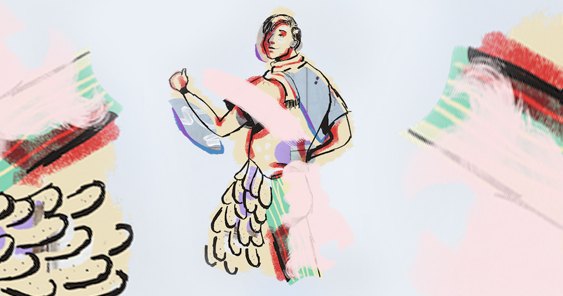By Mark Tungate
There’s a scarf I own that always makes me think of creativity. It’s long, stripy and rather eccentric- in red, white and blue—and it’s special because it was given to me by the British fashion designer Paul Smith.
The circumstances were quite specific. I was in Hong Kong attending a conference on luxury branding, organized by the International Herald Tribune. After his speech, Smith launched into a question-and-answer session. On the stage with him was a big bag of branded goodies, and he promised a gift for everyone who asked a question.
Mine was: “You’re the perfect incarnation of your own brand. What will happen to Paul Smith after Paul Smith has retired?”
Smith replied that he hoped he’d imbued the company with his own taste and style, so it could maintain its unique brand identity even after he’d gone. In other words, he’d filled it with his “creative spirit”. Then he invited me on stage to collect my scarf.
Smith was one of my heroes even before that incident, and I still remember what he said about creativity during his speech. It was all about keeping your eyes open and absorbing potential ideas. He said that he has once spotted a packet of seeds, covered in a photo of flowers, which turned into a pattern on a shirt. No wonder he wrote a book called You Can Find Inspiration in Everything.
As a journalist who’s been covering subjects like advertising, luxury and fashion for more than 20 years, I’ve been lucky enough to meet – and occasionally work with – some extremely creative people. Lately I’ve been trying to understand what they all had in common.
Around the time I met Paul Smith, another fashion designer, Jean-Paul Gaultier was exhibiting his work in Paris. Instead of showing regular clothes, he designed a collection made entirely of bread – mostly baguettes, since this was France. He called it “Pain Couture”. The creative lesson here, I think, is about disdaining convention and tapping into the absurd.
One fashion maverick I’ve worked quite closely with is Renzo Rosso, the founder of Diesel. I helped him with his autobiography, Fifty, on the occasion of his 50th birthday, and also with a book called Be Stupid, based on the advertising campaign of the same name.
The campaign, ‘Created by Anomaly,’ was based on the idea that the act of “being stupid” – derided by parents and pedants – is in fact a synonym for experimentation and curiosity. Renzo loved this idea, as he thought it reflected his life’s philosophy.
Brought up on a farm in northern Italy, essentially in the middle of nowhere, Rosso was unable to buy a pair of flared jeans as a teenager, but made a pair using curtain material and his mother’s sewing machine. Later, he mimicked the second-hand jeans being collected by denim snobs by creating “pre-destroyed” denim. In other words, he faked the vintage look. He was an Italian selling a new concept of jeans in America, the home of denim. And while they may have looked tatty, they were blisteringly expensive.
“I’ve done so many things in my life that might sound stupid, but turned out to be the right thing,” he told me. Once, he impulsively bought a crumbling art deco hotel in a then run-down section of Miami. Today the Pelican Hotel proudly stands on South Beach, one of the world’s most expensive strips of real estate.
So, creativity is also about favoring instinct over rationality. It’s a leap of faith. Renzo’s holding company is called Only The Brave.
One of the most underestimated traits in any discussion of creativity is a sense of humor. Without humor – or at least wit – it’s hard to achieve the lightness of heart that enables you to bring your dreams to life, whether it’s a garment made of bread, or a boy wizard who lives under the stairs. Some of my favorite ad people are also very funny. I’m thinking of Stéphane Xiberras, president and executive creative director of BETC here in Paris, and his campaigns for Canal Plus. They’ve featured talking bears and unicorns’ balls, among other things.
Creative people tend to be magpies, picking up influences here and there and then synthesizing them, so what emerges later on feels entirely original. I recently interviewed Mike Nicholson, the newly-appointed executive creative director of the agency Brave in London. He told me: “A lot of young creatives are happy to trawl the internet for stuff and create a kind of mash-up. The idea of creating something out of nothing, that nobody has seen before, and yet anchoring it to a brief, is pretty much what I’m about.”
One of the first creative people I met was Mr. Harris, my English Literature teacher at school, who is pretty much the reason I do what I do. He introduced us to Shakespeare by playing us the Dire Straits song Romeo and Juliet. He made connections between sonnets, rock music and Hollywood musicals. Later he read J.M. Synge’s The Playboy of the Western World with such unalloyed joy that we felt we were living in the play’s rural Irish community.
Which brings us to what may be most important element of creativity. Call it joy, call it a zest for life. But only one name really works: passion.
Mark Tungate is the editorial director of the Epica Awards, based in Paris. He is the author of several books about branding, advertising and the luxury industry.
Illustration by Alberto Cinco, Jr.







